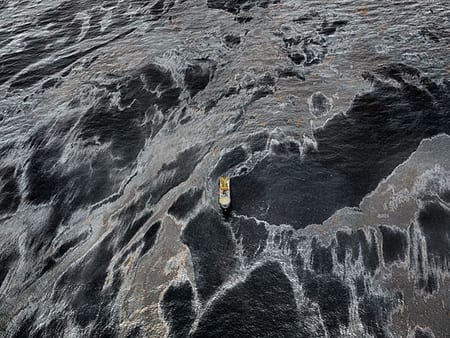By Daniel de la Calle
There is a mesmerizing power and intensity in tragedy, a fascination that traps the eye and pushes us toward it the way cliffs tempt bodies to fall. It is one of the main ingredients in most artistic expressions and I assume it must be linked to our desire to understand mortality.
Nine years ago I lived in downtown Manhattan and one morning woke up to the news from my brother in Spain that the WTC was on fire. I went up to the roof of the apartment building, where two workmen were drinking coffee with eyes glued to the flames and smoke on the first tower. I felt instantly drawn to it, not by some morbid attraction, simply because going there seemed to me like the only logical thing to do; it was something that could not be ignored. The thought of what ended up happening during the next couple of hours did not even cross my mind, so I had no fear. I simply grabbed the camera (I was studying at the ICP at the time) and walked South. Everyone that was close to the towers that morning has their own story about what they lived through. In my mind it all still plays like an impossible, absurd, slow dream. I recall single steps taken along the sidewalk, my glances up looking for that first tower that I did not know was gone, the white ash in the air, delicately laid on the pavement and on mailboxes, the smell, that toxic burnt smell. The scale, both in sheer size and in the number of deaths, of the catastrophe turned it forever intangible, incomprehensible, almost unacceptable for me, and the beauty of that morning enhanced this sensation, condemning me to this day to recall things with a mixture of detail and haziness. It was the day I realized I was just a sideline observer in life, that I was not made to be a photographer, or a hero, or a person touched by greatness. I just happened to be there, in a place I have not returned to. Every September I am forced to remember it all when I wake up one morning and there is that gorgeous and unmistakable blue sky that is so New York and so September Eleventh.
Edward Burtynsky’s OIL series depicts a tragedy in large scale, images full of detail, with perfect composition and eerie, confusing beauty. His work combines two of the playful aesthetic choices photography offers that I very much enjoy: the abstraction of reality from aerial shots (which surprisingly also occurs in macrophotography) and texturizing from stepping down from three to two dimensions. His most recent photographs for the exhibition, the ones you can see in the link above, were taken this spring during the spill in the Gulf of Mexico. They are so beautiful, so sad.



